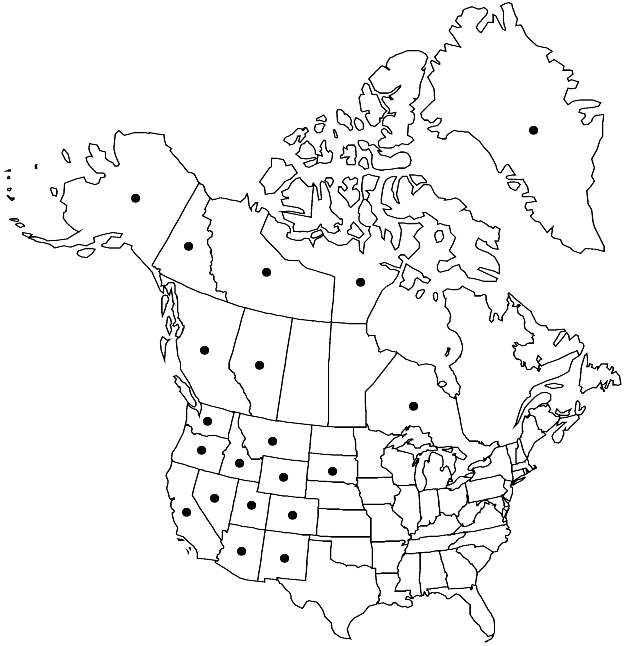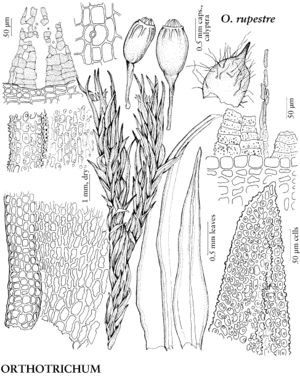Difference between revisions of "Orthotrichum rupestre"
Sp. Musc. Frond. Suppl. 1(2): 27, plate 53 [top]. 1816.
FNA>Volume Importer |
FNA>Volume Importer |
||
| Line 15: | Line 15: | ||
|name=Dorcadion rupestre | |name=Dorcadion rupestre | ||
|authority=(Schleicher ex Schwägrichen) Lindberg | |authority=(Schleicher ex Schwägrichen) Lindberg | ||
| − | }}{{Treatment/ID/Synonym | + | }} {{Treatment/ID/Synonym |
|name=Orthotrichum bullatum | |name=Orthotrichum bullatum | ||
|authority=Müller Hal. | |authority=Müller Hal. | ||
| − | }}{{Treatment/ID/Synonym | + | }} {{Treatment/ID/Synonym |
|name=O. californicum | |name=O. californicum | ||
|authority=Venturi | |authority=Venturi | ||
| − | }}{{Treatment/ID/Synonym | + | }} {{Treatment/ID/Synonym |
|name=O. douglasii | |name=O. douglasii | ||
|authority=Duby | |authority=Duby | ||
| − | }}{{Treatment/ID/Synonym | + | }} {{Treatment/ID/Synonym |
|name=O. macfaddenae | |name=O. macfaddenae | ||
|authority=R. S. Williams | |authority=R. S. Williams | ||
| − | }}{{Treatment/ID/Synonym | + | }} {{Treatment/ID/Synonym |
|name=O. rupestre var. globosum | |name=O. rupestre var. globosum | ||
|authority=(Lesquereux) Grout | |authority=(Lesquereux) Grout | ||
| − | }}{{Treatment/ID/Synonym | + | }} {{Treatment/ID/Synonym |
|name=O. rupestre var. macfaddenae | |name=O. rupestre var. macfaddenae | ||
|authority=(R. S. Williams) Grout | |authority=(R. S. Williams) Grout | ||
| − | }}{{Treatment/ID/Synonym | + | }} {{Treatment/ID/Synonym |
|name=O. texanum | |name=O. texanum | ||
|authority=unknown | |authority=unknown | ||
| − | }}{{Treatment/ID/Synonym | + | }} {{Treatment/ID/Synonym |
|name=O. texanum var. globosum | |name=O. texanum var. globosum | ||
|authority=Lesquereux | |authority=Lesquereux | ||
| Line 53: | Line 53: | ||
|elevation=low to high elevations (100-3000 m) | |elevation=low to high elevations (100-3000 m) | ||
|distribution=Greenland;Alta.;B.C.;N.W.T.;Nunavut;Ont.;Yukon;Alaska;Ariz.;Calif.;Colo.;Idaho;Mont.;Nev.;N.Mex.;Oreg.;S.Dak.;Utah;Wash.;Wyo.;South America;Europe;e Asia (Japan);n;e Africa;Atlantic Islands (Canary Islands);Pacific Islands (New Zealand);Australia. | |distribution=Greenland;Alta.;B.C.;N.W.T.;Nunavut;Ont.;Yukon;Alaska;Ariz.;Calif.;Colo.;Idaho;Mont.;Nev.;N.Mex.;Oreg.;S.Dak.;Utah;Wash.;Wyo.;South America;Europe;e Asia (Japan);n;e Africa;Atlantic Islands (Canary Islands);Pacific Islands (New Zealand);Australia. | ||
| − | |discussion=<p>In typical form, Orthotrichum rupestre is characterized as much-branched plants in loose tufts with lanceolate leaves, apex narrowly and bluntly acute, basal cells elongate, thick-walled, and nodose, yellowish in older leaves, capsule oblong, emergent, 8-ribbed to mid capsule when old and dry, smooth or slightly 8-ribbed when mature, exostome of 16 erect teeth, coarsely papillose, and calyptra with abundant, spinulose, papillose hairs, some of which extend over the beak.</p> | + | |discussion=<p>In typical form, <i>Orthotrichum rupestre</i> is characterized as much-branched plants in loose tufts with lanceolate leaves, apex narrowly and bluntly acute, basal cells elongate, thick-walled, and nodose, yellowish in older leaves, capsule oblong, emergent, 8-ribbed to mid capsule when old and dry, smooth or slightly 8-ribbed when mature, exostome of 16 erect teeth, coarsely papillose, and calyptra with abundant, spinulose, papillose hairs, some of which extend over the beak.</p> |
|tables= | |tables= | ||
|references= | |references= | ||
| Line 76: | Line 76: | ||
|publication year=1816 | |publication year=1816 | ||
|special status=Selected by author to be illustrated | |special status=Selected by author to be illustrated | ||
| − | |source xml=https://jpend@bitbucket.org/aafc-mbb/fna-data-curation.git/src/ | + | |source xml=https://jpend@bitbucket.org/aafc-mbb/fna-data-curation.git/src/8f726806613d60c220dc4493de13607dd3150896/coarse_grained_fna_xml/V28/V28_95.xml |
|genus=Orthotrichum | |genus=Orthotrichum | ||
|species=Orthotrichum rupestre | |species=Orthotrichum rupestre | ||
Revision as of 17:09, 18 September 2019
Plants (1–)3–12.5 cm, light green to olive green. Stem leaves stiff, erect-appressed when dry, narrowly lanceolate to ovate-lanceolate, 2–4.5 mm; margins recurved to narrowly revolute to near apex, entire; apex sharply to slenderly acute; basal laminal cells elongate to rectangular, walls thick, ± nodose; distal cells 6–13 µm, 1-stratose, papillae 1 or 2 per cell, conic and small, or 2-fid and low. Specialized asexual reproduction absent. Sexual condition gonioautoicous. Seta to 1.8 mm. Capsule immersed, emergent, or slightly exserted, usually 1/3 emergent, globose ovate, ovate-oblong, or short-oblong, 1.3–1.8 mm, slightly or distinctly 8-ribbed 1/2–2/3 length; stomata superficial; peristome single, rarely double; prostome large, conspicuous, or rudimentary; exostome teeth 16, erect or sometimes spreading-recurved when old, smooth, scattered-papillose, or coarsely papillose-granulate; endostome segments absent, or rarely 8, rudimentary, of 1 row of cells, smooth or roughened. Calyptra oblong, smooth, hairy or rarely naked, hairs finely papillose. Spores 13–21 µm.
Habitat: Non-calcareous boulders and cliff faces in mesic areas of pine, spruce-fir, or aspen forests, base of trees, subalpine shade
Elevation: low to high elevations (100-3000 m)
Distribution

Greenland, Alta., B.C., N.W.T., Nunavut, Ont., Yukon, Alaska, Ariz., Calif., Colo., Idaho, Mont., Nev., N.Mex., Oreg., S.Dak., Utah, Wash., Wyo., South America, Europe, e Asia (Japan), n, e Africa, Atlantic Islands (Canary Islands), Pacific Islands (New Zealand), Australia.
Discussion
In typical form, Orthotrichum rupestre is characterized as much-branched plants in loose tufts with lanceolate leaves, apex narrowly and bluntly acute, basal cells elongate, thick-walled, and nodose, yellowish in older leaves, capsule oblong, emergent, 8-ribbed to mid capsule when old and dry, smooth or slightly 8-ribbed when mature, exostome of 16 erect teeth, coarsely papillose, and calyptra with abundant, spinulose, papillose hairs, some of which extend over the beak.
Selected References
None.
